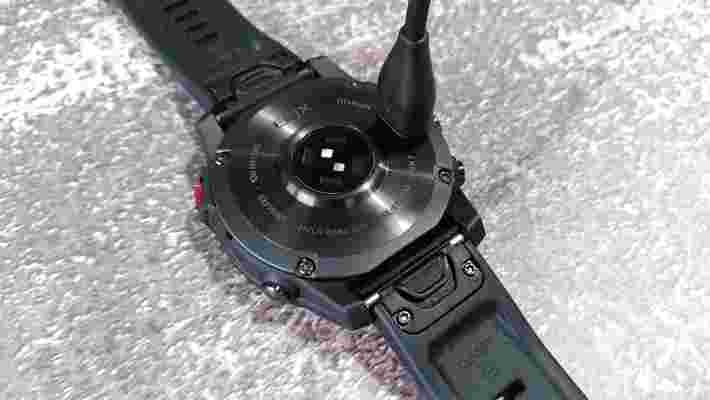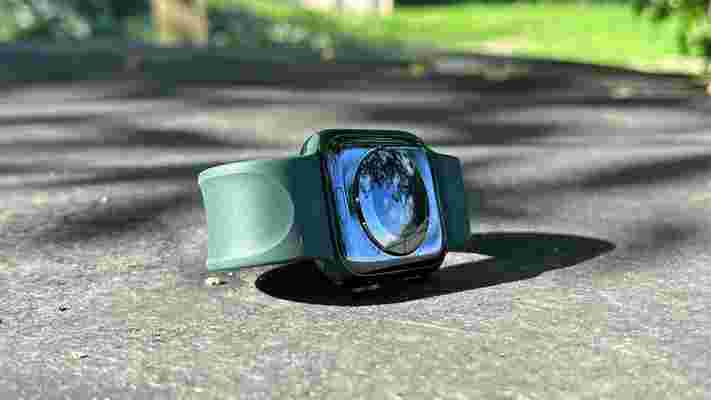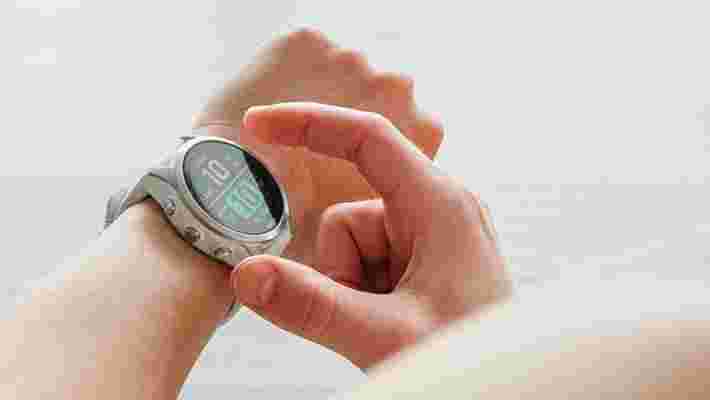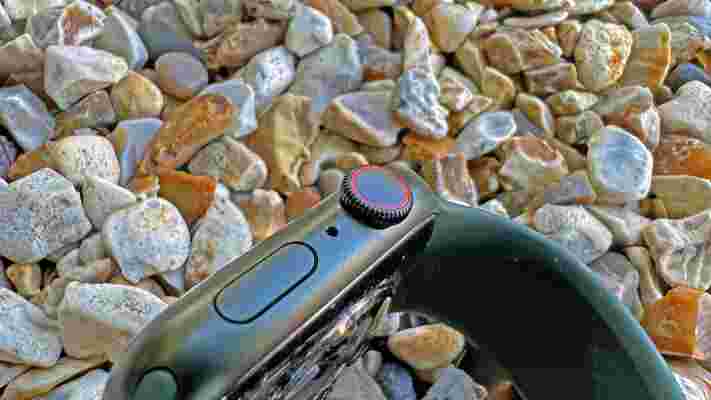We could soon see the first Garmin watch with both a bright OLED display and solar charging, giving you great-looking graphics and extra-long battery life. Garmin has registered a patent for an OLED display with a photovoltaic layer for use in portable electronic devices – and smartwatches in particular.
Until now, if you've been thinking of picking up a Garmin watch, you've had to make a choice: which do value more, battery life or display quality? Most of the watches in Garmin's current range (including the newly released Fenix 7 and Instinct 2 ) are available with the company's Power Glass, which keeps the battery topped up between charges. If your Instinct 2 Solar gets enough sunlight, it can even keep running indefinitely.
This is a huge boon for anyone who enjoys running or cycling outside, but there's a downside – these watches all use memory-in-pixel (MIP) displays, which although fine in most lighting conditions, aren't as vibrant as OLED screens. One of our few complaints about the Fenix 7 was the relatively low contrast and muddy colors of its display – an effect that's magnified by its blue-tinted backlight.
Looks or longevity
Watches like the Garmin Venu 2 , Venu 2 Plus , and Epix (Gen 2) are graced with vibrant OLED displays that look much sharper and make it easier to check messages and workout stats at a glance. Their higher refresh rate means they're also capable of displaying animated yoga and pilates workouts that you can follow along from your wrist.
However, OLED displays use more power than MIP, and none of these watches are available in photovoltaic variants. Their battery lives are nothing to be sniffed at (the Epix lasted two weeks in our tests with regular workout tracking), but they need charging more frequently.

"Battery life is important for these devices as it is aggravating for users to stop wearing a device for recharging," Garmin's patent explains. "Some attempts have been made to equip smartwatches with semitransparent solar panels such as by using a discrete solar cell positioned on top of (or over) the watch's display.
"However, the presence of such a solar cell overlay degrades visibility of the display module. Accordingly, there is a need for an integrated energy-collecting display module that collects solar energy without substantially obscuring its display."
An OLED display that's obscured by a photovoltaic layer would be no use, so instead, Garmin has devised an alternative that should give you the best of both worlds.
The best of both
All OLED displays use red, green and blue subpixels to represent different colors. Garmin's patent describes a type of display where, rather than placing a layer of photovoltaic material over the display, photovoltaic regions are interspersed in between the subpixels. It's possible that this type of display would be less bright and sharp than a standard OLED display, but at this early stage we can't say.
Although watches are perhaps the most obvious use for this type of display, Garmin explains that it could also work for hand-held GPS units similar to the InReach 2 launched earlier this year, or bike computers. These devices are designed for use outdoors, so solar charging makes a lot of sense, and an OLED display would make for bright, detailed maps that are easier to check when navigating.
It's impossible to say if or when this display tech will find its way onto runners' and cyclists' wrists; after all, a patent doesn't guarantee that a consumer product will ever hit the shelves. It sounds like a smart move for Garmin though, and one that would really give its outdoor adventure watches an edge.
Cyberpunk 2077 patch 1.5 livestream - all the biggest announcements
Cyberpunk 2077 patch 1.5 is finally here. After months of waiting, Night City runners are now able to download the patch that refurbishes the game to a degree, with many quality-of-life updates, free DLC and gameplay changes being added. Weighing in at approximately 50GB, it's a beefy patch, so you'll want to make sure your console's SSD has room to spare.
Patch 1.5 is available to download right now, with Xbox Series X /S players automatically receiving the updated next-gen version via Smart Delivery . PS5 players, meanwhile, will have to redownload the PS5 version of Cyberpunk 2077 from the PlayStation Store.
In case you missed the Cyberpunk 2077 patch 1.5 livestream, the full patch notes can be read on the game's official website. Alternatively, read on to find out all the biggest and best changes now available in Cyberpunk 2077's patch 1.5 update.
Cyberpunk 2077 next-gen upgrade

Cyberpunk 2077 patch 1.5 finally brings the game's next-gen version to PS5 and Xbox Series X/S consoles. The update boasts new Performance and Ray Tracing modes.
Performance mode supports 60fps at 4K, however developer CD Projekt Red admits that small, infrequent frame drops should be expected, perhaps unavoidable for a game as large as Cyberpunk 2077.
The Ray Tracing mode is slightly more disappointing. It drops the game to 30fps, and only supports local shadows as opposed to reflection-based ray-tracing. The trade-off there just isn't worth it in our opinion, but it's there to try out if you're looking for a console experience slightly closer to the PC version of Cyberpunk 2077, providing you don't mind a hampered frame rate, of course.
Additionally, PS5 players are getting haptic feedback functionality via the DualSense wireless controller , and Spatial Audio support via headphones which the Xbox Series X/S versions already received.
Cyberpunk 2077 patch 1.5 gameplay changes

Cyberpunk 2077 patch 1.5 brings gameplay improvements in some key areas. First up is a complete overhaul of the perk system. In some cases, entire perk trees have been retooled. One example is the Stealth tree, which has been rebranded as Ninjutsu. Players loading an existing save file will have to reassign all of their perk points, which the livestream hosts suggested was due to the overhaul being so broad.
Enemy AI has also received a bump. Enemies now better react to your actions, and are able to more effectively hide behind cover and potentially communicate with each other.
Driving has seen quite a substantial improvement, too. The driving model has been improved overall, and most vehicles will now have a more individual feel. Visual flourishes have also been added, such as rim lights on bikes and a better first-person view in cars. Finally, cars summoned from your garage will now arrive in different places relative to your location, instead of occasionally crashing into each other on arrival.
NPCs and crowds have also been improved on PS5 and Xbox Series X/S. More pedestrians than ever inhabit the streets of Night City, especially during the day. They'll also better react to events happening around them, such as running from gunfire. This also applies to drivers, who will attempt to flee the scene in a reckless panic.
Lastly, some big quality-of-life improvements come to Cyberpunk 2077's UI. The map interface is now far easier to read. Sidequest icons are now a shade of blue as opposed to the identical yellow of the main quests. Furthermore, icons can be filtered to help declutter the map and better find what you're looking for.
Sidequests have also been reworked to be more closely tied to each district's fixer NPCs. You'll now need to build up trust with each to unlock more gigs, as opposed to just having them all available on the map at once. A refreshing addition that should help progression feel less overwhelming.
Cyberpunk 2077 patch 1.5 DLC additions

Cyberpunk 2077 patch 1.5 features a healthy injection of free DLC on top of all the changes and improvements brought to the game. First up is new weapons added to the 2nd Amendment store near V's apartment. This DLC also brings to light a rebalancing of the game's economy, which includes better cash rewards for V, and making purchases like vehicles and weapons more affordable.
Another huge addition that players have been asking for since launch is the ability to customize V mid-game. Previously, once you'd left the character creation screen, that was it. Unless you modded your game on PC, you had no option to further tweak V's appearance in-game. Now, that can be done for free on PC and across all console versions by checking yourself in a mirror at your apartment.
New customization options have also been added, including new hairstyles, colors and makeup options. Plus, the lighting has been greatly improved for the character creation menu. No more reddish tint to give you a false idea of what your selections actually look like in-game.
The final big piece of content coming in Cyberpunk 2077 patch 1.5 is all-new apartments. A new website accessible from your apartment's PC lets you purchase new abodes all across Night City. New digs are found in places like Japantown, Northside and Corpo Plaza, and all apartments (including V's default home) can be customized with new makeovers, too.
Finally, if you're a fan of the characters in Cyberpunk 2077 (genuinely one of the game's strengths) then you'll be pleased to know that the game's romanceable NPCs like River Ward and Judy Alvarez have all-new interactions. To better facilitate the feeling of them being V's partner, you're now able to text and interact with them more frequently. They may also wake up next to you in your apartment, granting additional buffs.
Cyberpunk 2077 patch 1.5 is a pretty meaty one, then. Although, while the patch should go a ways to please existing fans of the game, it likely won't do anything for anyone lukewarm on it, or even those who are just on the fence.
The hour-long livestream didn't go into any intricate detail about bug fixes, which for many is understandably priority one when it comes to enjoying Cyberpunk 2077. Still, patch 1.5 and the next-gen upgrade are a solid step forward for the initially troubled release of Cyberpunk 2077, and we hope more improvements are planned for the future.
Garmin Fenix 7 vs Apple Watch 7: find your perfect smartwatch
If you're in the market for a new watch, the Garmin Fenix 7 and Apple Watch 7 are two that are likely to grab your attention. Both are packed with tools that'll serve you well whether you're working out or taking it easy, but they're very different devices and we're here to help you choose the one that's right for you.
The biggest difference here is that the Apple Watch 7 is an everyday watch with universal appeal, while the Garmin Fenix 7 is a serious sports watch. If you're not aiming to set new personal records and crush fitness goals, opting for the Fenix means you'll be paying for a lot of tools you're not going to use.
If you enjoy exercise for fun and recreation, the Apple Watch 7 will likely have everything you need – particularly when paired with an Apple Fitness Plus subscription. However, if you've set yourself a goal of crushing your marathon time, tackling an Ironman, taking on a sportive, or working on your trail running, the Fenix 7 will be a fantastic training partner.
Those aren't the only differences, though – design, price, battery life, and third-party support are all important considerations too. Scroll down for the full lowdown on both watches. Alternatively, if you've made up your mind, we've found the best prices for you right here:
Watch models
The Garmin Fenix 7 and Apple Watch 7 both come in various different configurations and sizes, which is well worth bearing in mind when choosing between them.
The Fenix 7 comes in eight different configurations. There are three sizes, with cases measuring 42mm, 47mm, and 52mm in diameter respectively. Each of these can be fitted with either Garmin's Power Glass or Sapphire Solar glass (the latter of which is more resistant to scratches). The two smaller models are also available with Corning Gorilla Glass.
This table shows how the various options compare:
| 42mm case | 47mm case | 52mm case | |
|---|---|---|---|
| Fenix 7S | Fenix 7 | n/a | |
| Fenix 7S Solar | Fenix 7 Solar | Fenix 7X Solar | |
| Fenix 7S Solar Sapphire | Fenix 7 Solar Sapphire | Fenix 7S Solar Sapphire |
All of the Fenix 7 models come in a choice of different colors and materials, including stainless steel, titanium, and DLC (diamond-like carbon) titanium.
The Apple Watch 7, by contrast, comes just two sizes: 41mm and 45mm. Neither size comes with solar charging or different types of glass for the lens, but both are available in a wide array of different materials and colors. Cases come in aluminum or stainless steel, and you can pick from a range of metal bracelets, silicone straps, and woven bands.
Both the 41mm and 45mm versions are available with cellular connectivity, which allows you to use online services and make calls without having your phone within Bluetooth range.

Price
The Garmin Fenix 7 series are top-end sports watches, with prices to match. They start at $699.99 / £599.99 / AU$1,049 for the standard 42mm or 47mm version, and the top-tier Fenix 7X Sapphire Solar is $999.99 / £859.99 / AU$1,499.
The Apple Watch 7 price starts at $399 / £369 / AU$599 for the 41mm variant, and rises to $429 / £399 / AU$649 for the 45mm model.
If you want the cellular version to allow you to use it without the phone, the 41mm version costs $499 / £469 / AU$749 and the 45mm model costs $529 / £499 / AU$799 – plus the cost of an additional data plan.
Whichever watch you choose, adding extras like premium case materials and leather straps will bump up the price. If you're buying an Apple Watch 7, you might also want to consider factoring in the price of an Apple Fitness Plus subscription, which will unlock tools like Time to Walk and Time to Run , plus Apple's full range of instructor-led workouts.

Design
The most obvious physical difference between these two watches is that the Apple Watch 7 has a rectangular face while the Fenix 7 is round, but that's only scratching the surface.
Both watches have touchscreens for scrolling through menus, selecting apps, and panning across maps. The Apple Watch 7 also has a single physical button that serves to navigate back through menus, plus a Digital Crown that can be rotated to scroll, and pressed to select options.
The Fenix 7 has five physical buttons, which are designed for use with wet, cold or gloved hands. The touchscreen is disabled by default during workouts to avoid accidentally pausing or ending workouts, and you can choose to switch it off altogether if you prefer to stick with the buttons alone. The start button has a metal guard to protect against damage and, again, avoid accidental presses.
Watches in the Fenix 7 line have an overall chunkier design than Apple Watch 7 devices, built to withstand rough treatment outdoors, and their cases are made from different materials. The Apple Watch 7 has an entirely metal case (either aluminum or stainless steel), whereas Fenix 7 cases are made from fiber-reinforced resin with a metal front.

Despite that, there's not much difference in weight. The 41mm Apple Watch 7 weighs 42.3 g, not including the strap, while the 45mm version is 51.5g.
The 42mm Garmin Fenix 7S weighs 47g, the 47mm Garmin Fenix 7 is 56g, and the 52mm Garmin Fenix 7X Solar is 68g. Part of the Fenix 7X's weight can be attributed to the LED flashlight fitted into the top of the watch, which can be activated by double-pressing the backlight button.
All Apple Watch 7 devices are topped with sapphire crystal glass. The standard Garmin Fenix 7 has Corning Gorilla Glass, while the solar editions come with either Garmin's own Power Glass or Power Sapphire.
Display
The Apple Watch 7 has a bright AMOLED display with an always-on modem while watches in the Fenix 7 line have transflective memory-in-pixel (MiP) displays.
MiP is less bright, but contributes to the Fenix 7's extra-long battery life. It's not as striking as AMOLED, but is still clearly visible in most lighting conditions, and has a backlight that can be activated with a press of the top right button.
Battery life
One of the biggest differences between the Garmin Fenix 7 and Apple Watch 7 is battery life. Whichever model you choose, the Fenix 7 lasts much, much longer between charges.
The table below shows the maximum quoted figures for the standard 47mm Garmin Fenix 7 and the Apple Watch 7:
| Garmin Fenix 7 | Apple Watch 7 | |
|---|---|---|
| Smartwatch mode | 18 days | 18 hours |
| Battery saver smartwatch | 57 days | n/a |
| GPS only | 57 hours | 7 hours |
If you mostly train outdoors, it's well worth checking out the Fenix 7 solar models, which last a remarkably long time between charges provided they get a regular dose of sunlight. Battery life for the 52mm Fenix 7X Solar is particularly impressive due to its extra large solar cell.
To give you an idea, here are the battery lives of the 47mm Fenix 7 Solar and the 52mm Fenix 7X Solar with three hours of direct sunlight per day. As you can see, size really does matter.
| Fenix 7Solar | Fenix 7X Solar | |
|---|---|---|
| Smartwatch mode | 22 days with solar | 37 days with solar |
| Battery saver smartwatch | 173 days with solar | 1+ year with solar |
| GPS only | 73 hours with solar | 122 hours with solar |
Smartwatch features
When it comes to general smartwatch features, it's perhaps no surprise that the Apple Watch has the most to offer. It integrates seamlessly with your iPhone, giving you easy access to your calendar, emails, address book, maps, and much more.
While you can certainly wear the Garmin Fenix 7 as a regular watch (and Garmin's mapping makes it superb for everyday navigation), it doesn't offer the same breadth of tools as Apple's watch. For starters, there's a much wider array of third-party apps available for the Apple Watch 7. Garmin does have an app store (Garmin Connect IQ), but there's less choice and most of the apps are sports-focused.
Another advantage of the Apple Watch 7 is its built-in microphone, designed for making calls and accessing Siri. This is something that's missing from the Fenix 7. In fact, so far the only Garmin watch with a microphone is the Garmin Venu 2 Plus .
Apple Pay is almost universally accepted in stores around the world. The Fenix 7 has Garmin Pay, but while this is supported by lots of banks and public transport networks in the US, it's less useful in the rest of the world.
The Apple Watch 7 is available with cellular connectivity if you want to use online tools without a connection to your phone, but at the time of writing there's no LTE version of the Fenix 7.
However, the Garmin Fenix 7 does have one big advantage as an everyday watch for many people: it's compatible with both iOS and Android.
Fitness tracking
The Garmin Fenix 7 is a dedicated sports watch, so as you'd expect, it has a far more comprehensive suite of workout monitoring and fitness tracking tools than the more general-purpose Apple Watch 7.
When we reviewed the Apple Watch 7, we were impressed by the accuracy of its heart rate monitoring, which closely matched that of the chest strap heart rate monitor we compared it to. We did, however, find that we needed to push the watch up our arm to get the most accurate readings. The Garmin Fenix 7 presented no such problems, and delivered extremely accurate measurements with no need for fiddling or adjustment.
Unlike the Apple Watch 7, the Fenix 7 has a skin temperature sensor that keeps tabs on your temp during workouts. This data is also used to estimate how much sweat you lose during a training session so you can make sure you rehydrate thoroughly afterwards.
Both watches can track a range of activities, and have on-board GPS to monitor your pace and distance during outdoor workouts, but the Fenix 7 offers many more modes, with training tools designed by people with an intimate knowledge of each sport. Runners and cyclists are particularly well catered for; a real-time stamina meter to show how much juice you have left in the tank, automatic climb detection, suggested training sessions, estimated race finish times, and smart pacing strategies are just a small handful of the tools on offer.
You can also use any Fenix 7 to check your seven-day training load on your wrist. This is presented as a bar chart showing your training load each day, the type of training (base, tempo, threshold, speed etc) represented by a color, and whether your tracked activities are having a positive impact on your fitness. You'll also see a number representing your training load that will help you judge if you're at risk of under- or over-training.
Although there are downloadable golf apps for the Apple Watch 7, the Fenix 7 comes with everything a golfer needs pre-installed. That includes details of some 42,000 courses, shot detection, digital scorecards, a full vector map, and much more. It's also legal for use in tournaments.
When you're not working out, both watches include SpO2 sensors for keeping track of blood oxygen saturation, as well as sleep tracking features that use the optical heart rate monitor and accelerometer to determine sleep quality and stages.
One feature that the Garmin Fenix 7 lacks is an ECG sensor to detect signs of atrial fibrillation (an irregular heart rhythm that should be investigated by a doctor). Anyone can develop atrial fibrillation, including the type of serious athletes who'll be wearing a Fenix 7, but so far it's not something that any Garmin watch offers.